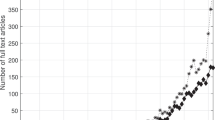Abstract
Contemporary pastoral counseling includes three paradigmatic elements: the image of the counselor as priest; the location of the human problem at the organismic-environmental interface; and the diagnosis of the human problem as alienation from self and others. These assumptions ought to be supplemented by the image of the counselor as prophet, by location of the human problemalso at the interface of the self and the ultimate, and by a diagnosis of the human problem as alienation from transcendence. To be adequate as a response to the total human situation, pastoral counseling theory must be expanded to include consideration of the transcendent dimension of human existence, and pastoral counseling method and technique must be modified to overcome alienation from the ultimate by facilitating the actualization of transcendence.
Similar content being viewed by others
Reference Notes
Thomas S. Kuhn,The Structure of Scientific Revolutions (Chicago: University of Chicago Press, 1962). Quoted by Kenneth R. Pelletier and Charles Garfield inConsciousness: East and West (New York: Harper & Row, Harper Colophon Books, 1976), p. 5f.
Robert Ornstein,The Psychology of Consciousness San Francisco: W. H. Freeman and Company, 1972), p. 1.
William A. Clebsch and Charles R. Jaekle,Pastoral Counseling in Historical Perspective (Englewood Cliffs, N.J.: Prentice-Hall, 1964).
This image of the counselor-prophet is taken from Sidney Jourard,Healthy Personality, 3rd ed. (New York: Macmillan Co., 1974), p. 343.
Ibid.This image of the counselor—prophet is taken from, p. 344.
Ibid.This image of the counselor—prophet is taken from. p. 347.
Ibid.This image of the counselor—prophet is taken from. p. 346.
Paul Johnson,Person and Counselor (Nashville: Abingdon Press, 1967), p. 54.
Howard Clinebell,Basic Types of Pastoral Counseling (Nashville: Abingdon Press, 1966), p. 46.
Johnson,Person and Counselor, p. 154.
See John Lilly,The Human Biocomputer (New York: Julian Press, 1967) and Joseph C. Pearce,Exploring the Crack in the Cosmic Egg (New York: Julian Press, 1974).
Aldous Huxley,The Doors of Perception (New York: Harper & Row, Harper Colophon Books, 1963), p. 23.
William Janes,The Varieties of Religious Experience (New York: New American Library, 1958), p. 298.
Huxley,Doors of Perception, p. 24.
Abraham Maslow,The Farther Reaches of Human Nature (New York: Viking Press, 1971), pp. 269ff.
Herbert W. Richardson, “Three Myths of Transcendence,” inTranscendence, ed. Herbert W. Richardson and Donald Cutler (Boston: Beacon Press, 1969), p. 104ff.
Ibid., p. 112.
Author information
Authors and Affiliations
Additional information
His article is a revision of the keynote address he presented to the American Association of Pastoral Counselors at their annual meeting in May 1976.
Rights and permissions
About this article
Cite this article
Hendrix, H. Pastoral counseling: In search of a new paradigm. Pastoral Psychol 25, 157–172 (1977). https://doi.org/10.1007/BF01759745
Issue Date:
DOI: https://doi.org/10.1007/BF01759745




